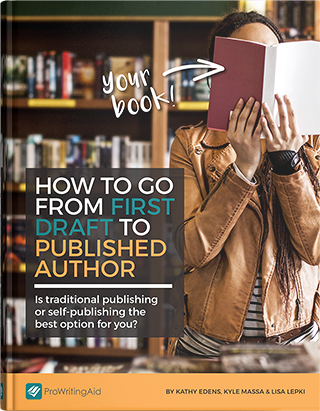
The dreaded blurb! It seems like authors everywhere hate writing book descriptions and with excellent reason. It’s hard to take tens of thousands of words and distill them down to 200 or less in a way that captures the essence of your book and compels readers to buy without sounding zealous.
I used to write all my blurbs based on the same formula. Until I read Adam Croft’s book, Writing Killer Blurbs and Hooks. This book showed me not all blurbs fit the same formula. Instead, you need to write the blurb that works best for your genre and your book.
To dig deeper into writing a book description that’s right for your book, I searched several bestsellers and recent releases in the Kindle store to analyze a few popular genres based on these four criteria:
1. Above the Fold
The area above the fold is what shows before you have to click the “read more” link. So, for this section, I want to know what is listed and whether it shows in bold. Is there something catchy that makes me want to click the “read more” link?
2. Headline or Hook
If the publisher has used a headline or hook, this will normally appear above the fold as the first sentence. A catchy tagline would fall into this category as well. Here I’m looking to see if there is one.
3. Description Body
For the body of the book description, I’m looking to see how long it is and what types of details it includes.
4. Call to Action
A call to action is a statement (at the end of the book description) that asks the reader to “buy now” or something along those lines. Here, I’m curious how many book descriptions include a call to action. Calls to action can be controversial with some authors and publishers thinking they are too zealous.
Mystery, Suspense, and Thriller
Let’s start with mysteries and thrillers. I recommend Adam Croft’s book if you want an in-depth look at writing a blurb for this genre. The information he presents on hooks is excellent. He suggests wording it in the second person to grab the reader.
Here’s the hook from Her Last Tomorrow:
Could you murder your wife to save your daughter?
That sure makes me want to read the book!
The text above the fold was written in bold font for all but one book I viewed in the thriller/mystery category on the Kindle bestsellers list. I saw accolades such as “Wall Street Journal best-selling author”, one book used a tagline, and one had several one-line quotes from Goodreads reviewers above the fold.
The most common use of the space above the fold was a combination of accolades and a hook, all woven into the same sentence. Here are two examples:
Amos Decker—the FBI consultant with a perfect memory—returns to solve a gruesome murder in a booming North Dakota oil town in the newest thriller in David Baldacci's #1 New York Times bestselling Memory Man series. (Walk the Wire by David Baldacci)
For a Florida police diver, danger rises to the surface in an adventurous thriller by the Wall Street Journal bestselling author of The Naturalist. (The Girl Beneath the Sea by Andrew Mayne)
If there was no hook above the fold, then the description included it as the last line. Here’s an example from Kendra Elliott’s The Last Sister: “Because when Tara disappeared, she took a secret of her own with her.”
The length of the descriptions in the mystery/thriller genre were two or three brief paragraphs, and none of the descriptions I looked at included calls to action. The paragraphs were laid out in such a way that paragraph one set the stage, paragraph two provided an intriguing event, and paragraph three ramped up the tension.
Romance
There were two consistencies I noticed for book descriptions in the romance genre. Most of the descriptions started with a hook combined with an accolade in one sentence, much like the mysteries and thrillers. Also like the mysteries and thrillers, none of the bestsellers I looked at included calls to action as part of their book descriptions.
It seems like there are many successful approaches for the body of the book description. Some used 2-3 brief paragraphs, and some used several paragraphs of only one or two sentences.
As far as what the description comprised, like the thrillers and mysteries, some used the pattern of set-up, inciting incident, then ramping up the tension, but others used more character-based descriptions. This works well for romance because this genre is based on relationships.
Some descriptions were set up with each principal character having their own paragraph, then the conflict between the characters also getting its own paragraph.
Science Fiction
In the science fiction genre, once again, most of the book descriptions I reviewed started with a hook or tagline above the fold written in bold. The body of the descriptions were longer than other genres (a few paragraphs). The tension as the description went on and the last paragraph often contained praise for the book.
There were no calls to action in any of the sci-fi book descriptions I read.

Memoir
The memoir book descriptions I read favored lengthy descriptions (three paragraphs or more). Accolades, such as best-seller, were featured most often above the fold.
One interesting thing I noticed about the memoir book descriptions was that they were all written in third person. I found this interesting, because most memoirs are written in first person. Third-person allows the reader to feel like they are getting a sneak peek of the author’s life by being on the outside looking in.
Non-Fiction
A question, a tagline, or a hook/accolade combination was placed above the fold for the non-fiction book descriptions I viewed. Each appeared as often as the other. I would argue the questions also acted like a hook because they always called out a pain point a reader might have. For example, the questions asked for Master Your Emotions by Thibaut Meurisse are: “Want to overcome negative feelings? Feel like you aren’t good enough? Need help dealing with stress?”
Those questions hooked me!
The most popular body for nonfiction book descriptions starts with “here’s what you’ll learn” or “you’ll discover” then lists the major benefits of purchasing the book. This is often a variation of the table of contents.
One-third of the non-fiction book descriptions I reviewed ended with a call to action like, “Buy now to discover xyz.”
Takeaways
The best thing you can do when writing your book blurb is to read a lot of other blurbs in your genre. While the differences may be subtle, readers pick up on this. Consider what you want to stand out most about your book and include that above the fold.
If you’re a bestselling author, incorporate that. If you’re an unknown author, then write an interesting hook. For romance, review book descriptions in your specific subgenre to see how other authors have structured their book description.
The body of your book description should build on your hook or tagline and avoid using calls to action unless your book is nonfiction. Writing book descriptions can be daunting, but with a little research and practice, you’ll be grabbing the attention of new readers in no time.


